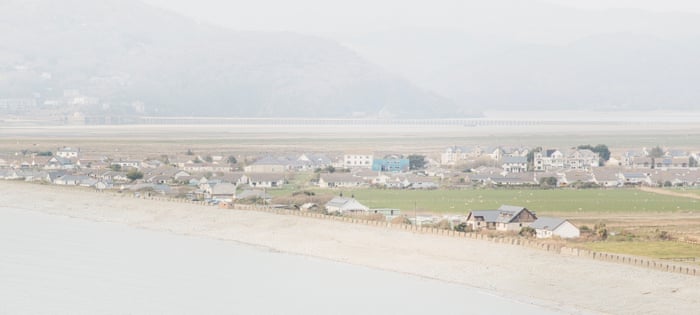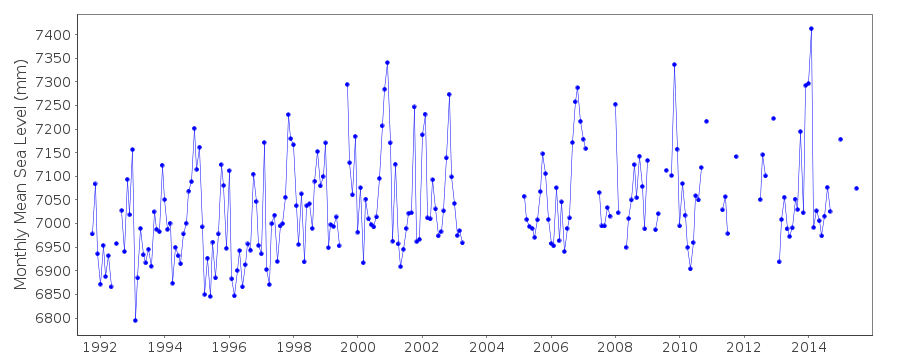Welsh Village To Be Sacrificed To Satisfy Global Warming Zealots
By Paul Homewood
h/t stewgreen
Apparently Jeremy Vine has been spinning for the climate team on his show today!
https://twitter.com/BBCRadio2/status/1130790359745912832
Understandably the locals are furious:
https://twitter.com/PeterHu65796484/status/1130804309111824386
And, surprise, surprise, the story is lifted straight from the Guardian:
As sea levels rise, Fairbourne, sandwiched between mountains and the beach, is being returned to the waves. But where will its residents go?
It is an almost perfect spring day. The sky is milky blue and there is barely a ripple on the mirror-flat expanse of Barmouth Bay. The sunshine is warm and the mountains are beginning to turn from slate-grey to luscious green. Bev Wilkins, a former businesswoman, launches a ball down the beach for her beloved German shepherd rescue dog, Lottie. In a blur of legs and black fur, the dog dashes into the frothy surf. “It is a lovely spot when the sun comes out,” she says, welcoming her dripping pet back with an affectionate rub. “Horrible when it rains.”
This is how Wilkins, 67, expected to spend her retirement when she sold her family home in Warwick and moved to Fairbourne, in north Wales, in 2002. For many years it was blissful: she spent her summers swimming in the sea and drying off in the back garden. Winters were harder, although she always had the views of Snowdonia’s rugged slopes to lift her spirits. But if Wilkins lasts nearly as long as her mother, who is 98 and also lives in the village, she could be among the first residents to be moved out: Gwynedd council has decided it can no longer defend her home from rising sea levels driven by increasing global temperatures.
“This is a wake-up call for the country,” she says, making her way up the steep shingle bank to the wall that protects her white bungalow from the waves. “This is going to happen elsewhere. Sometimes you have to see someone else go through it – we just happen to be the first.”
In 26 years – or sooner, if forecasts worsen or a storm breaches the sea defences – a taskforce led by Gwynedd council will begin to move the 850 residents of Fairbourne out of their homes. The whole village – houses, shops, roads, sewers, gas pipes and electricity pylons – will then be dismantled, turning the site back into a tidal salt marsh.

It will become the first community in the UK to be decommissioned as a result of climate change; while other villages along England’s crumbling east coast have lost houses to accelerating erosion, none have been abandoned. It may also create hundreds of British climate refugees: the residents of Fairbourne are not expected to receive any compensation for the loss of their homes, and resettlement plans are unclear.
It will not be the last village to meet this fate. Sea levels around the UK have risen by 15.4cm since 1900, and the Met Office expects them to rise by as much as 1.12m from modern levels by 2100, putting at risk communities in coastal floodplains and on sea cliffs, which are found around much of the east and south coast of England. The west of Wales and north-west England are also vulnerable. Even if the world’s governments succeed in reversing increasing emissions in line with their Paris climate commitments, sea levels are set to rise for centuries, as the impact of higher global temperature and warmer oceans takes effect.
This story has been developing for a few years, and I covered in this post in 2016.
I can’t do better than re-posting most of it here, with some updated graphs:
Fairbourne is on the West Wales coast, on the edge of the Snowdonia National Park
.

Across the estuary, there is a tidal gauge at Barmouth. It only started in 1991, and there have been some missing months in between. However, it is immediately apparent that there has been little change in sea level in the last decade.

Tide Gauge at Barmouth
https://www.psmsl.org/data/obtaining/stations/1771.php
We find a similar trend at Fishguard, just down the coast.

Tide Gauge at Fishguard
https://www.psmsl.org/data/obtaining/stations/1731.php
And at Llandudno on the north Wales coast:

Tide Gauge at Llandudno
https://www.psmsl.org/data/obtaining/stations/1854.php
What is particularly relevant are the peaks, as these are what will cause potential flooding. These naturally tend to coincide with storm events, and there is no evidence at all that these are getting significantly higher.
At Llandudno, the rate of sea level rise has been 2.16mm/yr, similar to most sites around the UK:
https://www.psmsl.org/data/obtaining/stations/1854.php
The nearest tidal gauge with long term and complete data is Newlyn in Cornwall. Newlyn is a couple of hundred miles away, so there will be some small differences, not least because the land is sinking there at a rate of about 0.5mm/year, whereas the area around Fishbourne is pretty much stable.
Nevertheless, any major changes in the rate of sea level rise would be equally as apparent there. NOAA tell us that sea levels at Newlyn have been rising at the rate of 1.81mm/year since 1915, with no evidence of acceleration.
https://tidesandcurrents.noaa.gov/sltrends/sltrends_station.shtml?id=170-161
By 2045, when the bulldozers are due in, sea levels will have risen by a tiny 47mm at current rates.
Talk of more than a meter of sea level rise by 2100 is highly irresponsible, especially when plans to demolish villages are made as a direct result.
As for the Guardian’s stupid claim that coastal communities will soon be at risk around the UK, I say bull. Fairbourne is in a particularly vulnerable position, and cannot be compared to other coastal towns, which are under no threat at all.
Comments are closed.





“….will then be dismantled, turning the site back into a tidal salt marsh.”
They built a village on a salt marsh and din’t expect the tide to come in one day?
How many years have people been saying that building on vulnerable, and valuable, low lying land is simply a disaster waiting to happen?
Hidden in this is the belief that the Collective has authority over the people. The people of Fairbourne have decided where they want to live. For their reasons. The Collective knows better. Or just wants to burn them for show. The Collective should have no authority over them.
According to the likes of Extinction Rebellion we only have 12 years left to save the planet so who will be around to organise this evacuation 14 years after Armageddon?
Typo? ‘lies’ for ‘likes’
“Tidal salt marsh”…at least that will mean no complaints from WWF, RSPB etc etc.
Many of such settlements only survive because public funds have been applied to maintain the defences for generations. In that sense the settlements are artificial anyway. As in Norfolk managed retreat is the considered alternative where the cost of coastal defence has become unaffordable.
Don’t worry. There’ll be a welcome in the hillside…..
Pity they can’t declare the village to be a Dutch dependency. The Dutch have a way of keeping the sea away from their settlements.
while other villages along England’s crumbling east coast have lost houses to accelerating erosion, none have been abandoned.
I assume that the inhabitants of Dunwich have been issued with snorkels for the past few hundred years.
http://www.dunwich.org.uk/history/
The difference today is that we are perhaps better equipped to deal with coastal erosion, although the Dutch had worked on the problem with some success for centuries. That the threat exists at all on the present scale is in part due to EU environmental policies.
Dunwich loss is different
The Wales village fears sea level rise, whereas Dunwich was lost due to coastal erosion
Its coast is quite high, it’s just the cliffs get eroded.
It’s not certain how much coastal erosion is affected by sea level rise, but Dunwich would have still been lost if sea level didn’t rise.
Coastal erosion is a natural process that happens without Climate Change , but is probably speeded up if there is more energy in the weather system
Don’t believe it till you hear it on The Archers 😆
Harlech Castle 20 mls north up the coast from Fairbourne. Harlech Castle used to have a sea gate, now its a mile inland? Is that indicative of rising sea levels? Will Royal St David’s Golf Club be sacrificed to give Harlech back its sea gate?
Exactly, the Cardigan Bay coastline is rising out of the sea. The painting of Harlech Castle over the great fireplace in the castle shows the sea crashing onto the rocks below the walls. That was 350 years ago now you have to cross a road, a railway line and go through a housing estate to get to the sea,
These people are maroons.
I was going to say exactly the same. Great minds and all that.
Building right on the edge of such an estuary is a particularly stupid thing to do in the first place. Is it OK to say such a thing or would that be a hate crime against the Welsh?
They had their reasons. Your presumption that they were stupid marks you as stupid. They made their decision based on what was important to them. Whether you approve is of no interest to them.
What the people of Fairbourne do is no one else’s business.
I think there have been a few places where the sea has been allowed to take back some drained salt marsh to take the pressure off the sea walls at high tides. These have been successful but no villages were moved to do this. I wonder how much the council actually spend on sea defence maintainance.
Gerry, not just spending on sea defences but spending on dredging of silted up estuaries.
Thomas Love Peacock’s book “The Misfortunes of Elphin” is based on Welsh legends from the seventh century which tell of the inundation of the plain of Gwaelod which was a little bit north of where Fairbourne is now. Old tree stumps can still be seen at low tide. You’d think they’d have learnt by now.
Perhaps Paul should offer to do some consultancy for the community, to be paid for out of reduced insurance premiums when the insurers are forced to admit there isn’t a problem?
Paul: “What is particularly relevant are the peaks, as these are what will cause potential flooding. These naturally tend to coincide with storm events, and there is no evidence at all that these are getting significantly higher.”
Could they have also occurred during the Winter or the Spring thaws, when I would have thought the run off from Snowdonia would be substantial?
I have been on the beach on a northern Scottish coast in February when winter and summer happened during the same day. The water run off, from not particularly high ground and just a little snow, was surprising in the quantities of water and its effects on the sand, above and below ground.
The worrying subtext to all this is that the head of the Environment Agency, responsible for maintaining flood defences, is using catastrophic global warming and sea level rise to soften up people to accept that they are not going to fund improvements in sea defences in some areas. They appear to be cynically using climate change as an excuse for implementing a new policy of letting the sea reclaim areas of previously drained saltmarsh. Those who lose their homes and their livelihoods get the dubious ‘privilege’ of being named as Britain first ‘climate refugees’ – minus any compensation of course.
“England’s flood planners must prepare for the worst on climate change, the Environment Agency has warned.
Its chairwoman, Emma Howard Boyd, said on current trends, global temperature could rise between 2C and 4C by 2100 and £1bn a year would need to be spent on flood management.
She said some communities may even need to move because of the risk of floods.”
https://www.bbc.com/news/science-environment-48206325
Yes, they use it as an excuse to NOT spend money – on anything other than their salaries.
It is about time the green persecuted electorate in such areas which by my copy of the Making of the English Landscape p.51. (W.G.Hoskins) was just about every village in the country who were settled by Saxons because Saxons built every village on a floodplain in a river valley, just upped and formed a new municipality i.e. New Boscastle, Tewkesbury and leave their abusive Fabian county council, what is good for Berwick-upon-Tweed is good for everyone. They can then do a bit of poldering & dredging since the majority of settlements require maintainence of the environment to be viable. At the end of the day of course it is up to them to simply do it.
Reblogged this on Climate- Science.
The words ‘natural erosion’ are anathema to the global warming zealots who see only bad in everything related to our beautiful climate. But there is an upside to this man’s stupid outpourings, at least for some. By his irresponsible statements he must have effectively reduced the value of every property in Fairbourne by at least 50 per cent if they are going to be redundant in 26 years time. I shall be travelling to Fairbourne next week to snap up one or two properties along the beach!. But it is a downside for the residents If I were a resident of Fairbourne I would ask the Council and people of the town, take this silly interviewee to task in no uncertain terms for reducing every single resident’s financial assets in such a mindless way.
TRIPE!!!-Sea level at any datum point is affected by say, on onshore breeze, a natural tidal variation, or even a normal hot summer. -Water expands a little and it APPEARS to the ‘warmist’ cretins that they’re right, ( just for today) -so they leap into print with the usual spurious clap-trap we’re all so used to now. Fairburn will be fine if its defences are maintained.
Barry, you are right. But what about localised atmospheric pressure variations also? They can vary from one ‘Sea Area’ to the next, as frequently mentioned by the BBC on the Maritime and Coastguard Agency’s Met Office provided Shipping Forecast.
Then there are sandbanks and gravelbanks. These get moved around, thanks to storms, and in association with the on-shore winds you mention, may locally pile up water.
Visited Fairbourne today to see what all the fuss was about. Bumped into a local who had just had a visit from EIGHT local Council members to help her with relocation advice.
She was extremely angry about the situation, also with the BBC Vine programme.
I normally turn Vine off and have lunch, but yesterday I was in the car and continued to listen. Vine never listens to what people tell him and is a CAGW disciple. That item was no different, the obvious question about salt marches and flood plains wasn’t asked, nor was the statement about 8 metre high sea walls queried . The highlight was when the local Councillor had a go at him for spreading panic. A couple of sensible locals also rang in saying they hadn’t been consulted and actions by the county council were not helping them. I think Vine wasn’t happy that no Chicken Littles rang in.
I also looked at the issues with Fairbourne back in 2016.
Fairbourne originally came to prominence in the 2011 “West of Wales Shoreline Management Plan 2(SMP2)”. In particular the following graphic on page 16.
The projected sea level rises are in line with the top end of the range of estimates for RCP8.5. This scenario assumes that climate mitigation policies are a complete failure. In the UK we have the costs of climate mitigation policies and the people of Fairbourne have the costs of failure to adapt should policies fail.
The beach looks to be of pebbles. In 50 years, if projections are correct, that needs to be raised by 36cm or 15 inches. On that timescale, it does not seem a big job. A few weeks work for a small JCB should do the job.
Manic, I used to live on reclaimed salt marsh, only a mile from the sea defences. In December 2013, the east Coast experienced the most severe storm surge since the devastating flooding of 1953. I wandered along the sea defences the next day and the water had come up two thirds of the way. There was at least 2.5m to go before they were topped. So even if we get a metre SLR in the next 80 years (highly unlikely), they’ll still be plenty to go. All the EA has to do is maintain the existing defences and perhaps plan to increase their height by say 0.5 metres in the next 50 years. Is that really too much to ask? My guess is that over the next 20 years, they will scale down maintenance, house prices will plummet as a result, the area will go into rapid economic and social decline and sections will be ear-marked for progressive managed inundation, even though some of the most productive agricultural land in the UK can be found here. When questioned on this policy, the ideologically-led EA will just regurgitate the ‘climate crisis’ mantra.
This thing has been going on years
The residents want sea defences maintained
and the Council say
‘NoCanDo too expensive ..Climate Change scary scary ..so managed retreat’
2014 BBC
https://www.bbc.co.uk/news/uk-wales-north-west-wales-26491477
Bit of hyperbole from The One Show in March 2016